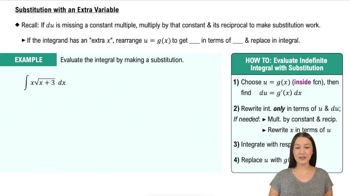If y = x² and dx/dt = 3, then what is dy/dt when x = –1?
Table of contents
- 0. Functions7h 54m
- Introduction to Functions16m
- Piecewise Functions10m
- Properties of Functions9m
- Common Functions1h 8m
- Transformations5m
- Combining Functions27m
- Exponent rules32m
- Exponential Functions28m
- Logarithmic Functions24m
- Properties of Logarithms36m
- Exponential & Logarithmic Equations35m
- Introduction to Trigonometric Functions38m
- Graphs of Trigonometric Functions44m
- Trigonometric Identities47m
- Inverse Trigonometric Functions48m
- 1. Limits and Continuity2h 2m
- 2. Intro to Derivatives1h 33m
- 3. Techniques of Differentiation3h 18m
- 4. Applications of Derivatives2h 38m
- 5. Graphical Applications of Derivatives6h 2m
- 6. Derivatives of Inverse, Exponential, & Logarithmic Functions2h 37m
- 7. Antiderivatives & Indefinite Integrals1h 26m
- 8. Definite Integrals4h 44m
- 9. Graphical Applications of Integrals2h 27m
- 10. Physics Applications of Integrals 3h 16m
- 11. Integrals of Inverse, Exponential, & Logarithmic Functions2h 31m
- 12. Techniques of Integration7h 41m
- 13. Intro to Differential Equations2h 55m
- 14. Sequences & Series5h 36m
- 15. Power Series2h 19m
- 16. Parametric Equations & Polar Coordinates7h 58m
4. Applications of Derivatives
Related Rates
Problem 3.8.10
Textbook Question
If r + s² + v³ = 12, dr/dt = 4, and ds/dt = –3, find dv/dt when r = 3 and s = 1.
 Verified step by step guidance
Verified step by step guidance1
Start by differentiating the given equation with respect to time t: \( \frac{d}{dt}(r + s^2 + v^3) = \frac{d}{dt}(12) \).
Apply the chain rule to differentiate each term: \( \frac{dr}{dt} + 2s \frac{ds}{dt} + 3v^2 \frac{dv}{dt} = 0 \).
Substitute the given values into the differentiated equation: \( 4 + 2(1)(-3) + 3v^2 \frac{dv}{dt} = 0 \).
Simplify the equation: \( 4 - 6 + 3v^2 \frac{dv}{dt} = 0 \), which simplifies to \( -2 + 3v^2 \frac{dv}{dt} = 0 \).
Solve for \( \frac{dv}{dt} \) by isolating it: \( 3v^2 \frac{dv}{dt} = 2 \), then \( \frac{dv}{dt} = \frac{2}{3v^2} \). Substitute the value of v when r = 3 and s = 1 to find \( \frac{dv}{dt} \).
 Verified video answer for a similar problem:
Verified video answer for a similar problem:This video solution was recommended by our tutors as helpful for the problem above
Video duration:
5mPlay a video:
Was this helpful?
Key Concepts
Here are the essential concepts you must grasp in order to answer the question correctly.
Implicit Differentiation
Implicit differentiation is a technique used to find the derivative of a function when it is not explicitly solved for one variable in terms of another. In this problem, the equation r + s² + v³ = 12 involves multiple variables, and we need to differentiate with respect to time t to find the rate of change of v, denoted as dv/dt.
Recommended video:

Finding The Implicit Derivative
Chain Rule
The chain rule is a fundamental principle in calculus used to differentiate composite functions. It is essential here because we are dealing with functions of multiple variables that change with respect to time. For instance, when differentiating s² with respect to t, we apply the chain rule: d(s²)/dt = 2s * (ds/dt).
Recommended video:

Intro to the Chain Rule
Substitution of Known Values
After differentiating the equation, substituting known values is crucial to solve for the unknown rate of change. In this problem, we substitute r = 3, s = 1, dr/dt = 4, and ds/dt = -3 into the differentiated equation to find dv/dt. This step simplifies the equation, allowing us to isolate and solve for the desired rate.
Recommended video:

Substitution With an Extra Variable

 4:16m
4:16mWatch next
Master Intro To Related Rates with a bite sized video explanation from Patrick
Start learningRelated Videos
Related Practice
Textbook Question
